Coronavirus Today: The Spotify showdown
Good evening. Iâm Karen Kaplan, and itâs Friday, Jan. 28. Hereâs the latest on whatâs happening with the coronavirus in California and beyond.
When it comes to COVID-19, anything can happen. Incredibly, that includes Neil Young replacing Dr. Anthony Fauci as Vaccine-Defender-in-Chief.
This week, the rock legend declared that he would no longer share space on Spotify with Joe Rogan, a wildly popular podcaster with a penchant for denigrating COVID-19 vaccines, promoting bogus COVID-19 âtreatmentsâ and saying things that undermine the work of people with actual expertise in virology, infectious diseases and public health.
âPlease immediately inform Spotify that I am actively canceling all my music availability on Spotify as soon as possible,â Young told his management team and record label. âI am doing this because Spotify is spreading false information about vaccines â potentially causing death to those who believe the disinformation being spread by them.â
The letter continued: âI want you to let Spotify know immediately today that I want all of my music off their platform. They can have Rogan or Young. Not both.â
Apparently, the last straw for Young was an interview Rogan conducted last month with Dr. Robert Malone, a researcher who takes credit for inventing mRNA vaccines but nonetheless claims they donât work. (They do: Depending on which report you cite, COVID-19 vaccines have saved between 240,000 and 1.1 million lives.) During his appearance on Roganâs Spotify podcast, Malone told listeners that âa third of the populationâ had âbecome hypnotizedâ through âmass formation psychosis.â
Youngâs ultimatum to the streaming service wasnât out of character. In his 76 years, he has written songs about political opportunism, racial inequality and religious extremism. He has also challenged corporate media and power structures that put profits ahead of principles; previous targets include MTV, David Geffen, Monsanto and Michael Jackson.
âI donât think Iâve ever met another artist who is so single-minded about standing up for what he thinks is right,â said record producer and publicist Bill Bentley, who writes a column for Youngâs website. âNeil doesnât change his views in terms of what itâs going to cost him in sales or anything else.â
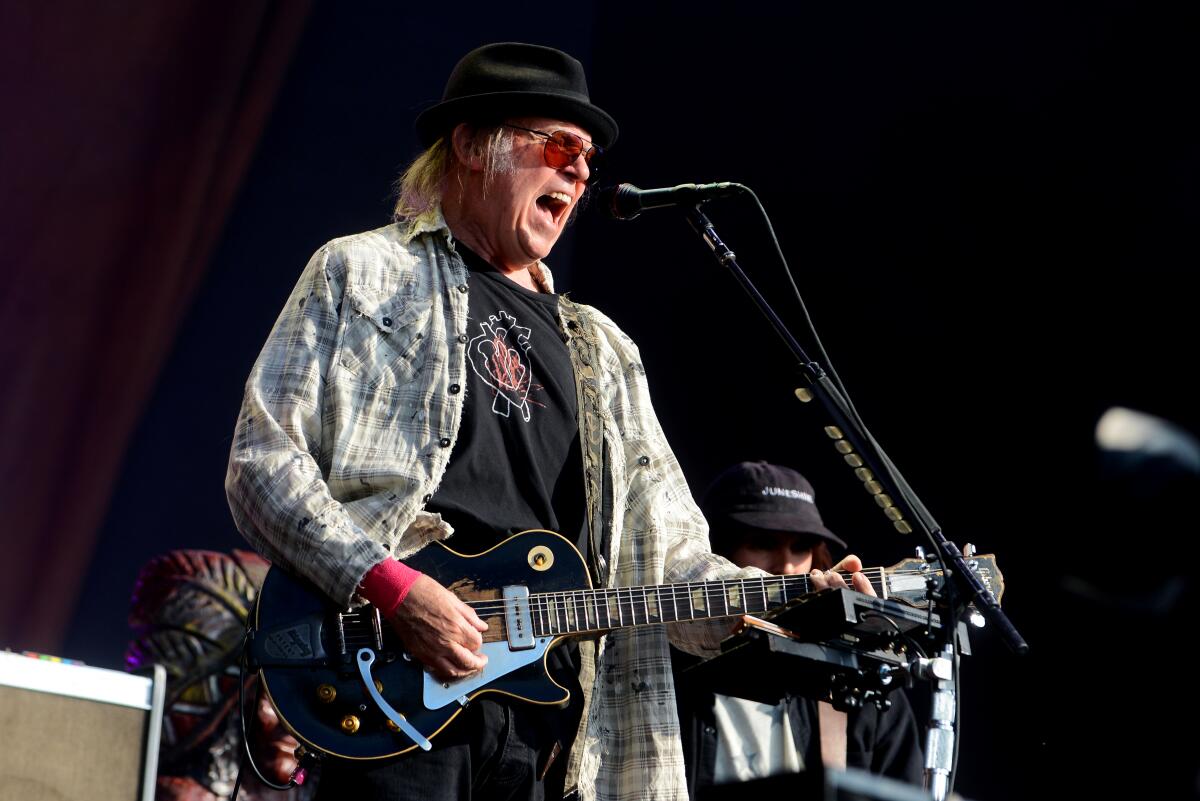
It didnât take long for Spotify to make its choice: Rogan.
Perhaps thatâs not surprising, since Spotify struck an exclusive distribution agreement with Rogan thatâs said to be worth about $100 million, and âThe Joe Rogan Experienceâ is its top-rated podcast. Beyond the value of this particular pact, the company is aggressively expanding into the podcast business through acquisitions and deals with influencers and production companies (including one launched by Barack and Michelle Obama).
Another clue: For the past few weeks, Spotify has been dodging questions about its murky policies with regard to misinformation. The company has said it bans âfalse or dangerous deceptive content about COVID-19, which may cause offline harm and/or pose a direct threat to public health.â If thatâs the case, itâs not reflected in the companyâs user guidelines or its summaries of prohibited content, my colleagues Matt Pearce and Wendy Lee note.
Youngâs fans were quick to make their displeasure known.
â@Spotify has chosen money over morality by choosing to remove Neil Youngâs entire music catalog over removing propaganda,â singer-songwriter Ricky Davila said in a tweet. âWhat a huge shameful disgraceful mistake.â
Geraldo Rivera was more succinct: âIâm with #NeilYoung.â
Rogan did not respond to The Timesâ request to comment, nor has he addressed the matter on his Twitter or Instagram accounts.
Spotify said it was doing its best to balance âboth safety for listeners and freedom for creators. ... We regret Neilâs decision to remove his music from Spotify, but hope to welcome him back soon.â
Thatâs not likely to happen. In a message on his website, Young encouraged other artists and record labels to follow him off the industry-leading streaming platform. âStop supporting SPOTIFYâs deadly misinformation about COVID,â he urged.
Today Joni Mitchell did just that. The singer-songwriter, 78, announced she was pulling her music off Spotify to join Young in his protest.
âIrresponsible people are spreading lies that are costing people their lives,â Mitchell said in a statement. âI stand in solidarity with Neil Young and the global scientific and medical communities on this issue.â
Young asked listeners to check out rival services from Amazon, Apple and Qobuz. (If youâre thinking of ditching Spotify, check out my colleague August Brownâs guide to other streamers.) The following day, SiriusXM satellite radio announced the return of a Neil Young channel for a limited engagement.
âMy music will live on in a better place,â Young wrote.
By the numbers
California cases and deaths as of 5:42 p.m. on Friday:

Track Californiaâs coronavirus spread and vaccination efforts â including the latest numbers and how they break down â with our graphics.
What itâs like in hospitals right now
For the second January in a row, hospitals are being overwhelmed with COVID-19 patients. But this yearâs surge has a different feel from last yearâs. Thanks to Omicron, the typical COVID-19 patient is not nearly as sick â but there are a whole lot more of them. My colleagues have been visiting hospitals around Southern California to see what things have been like for those who are sick â and for the people who take care of them.
The first stop on our tour is Martin Luther King Jr. Community Hospital in South Los Angeles. The community it serves was in relatively poor health prior to the pandemic. Now those coming down with COVID-19 are seeing their chronic health conditions exacerbated by the coronavirus.
The intensive care unit is no longer ground zero. This time, that honor belongs to the emergency department. The area that used to be the waiting room has been converted into treatment cubicles; so has space in a county building next door. Tents have been erected in the hospitalâs ambulance bay to house patients, but thereâs still not enough room for everyone.
A patient with the coronavirus must be isolated a room, and that makes the space crunch even worse. So does the fact that it takes longer to discharge patients to nursing homes and other health facilities, which are also short-staffed as a result of Omicron.
One unvaccinated patient with chest pain and breathing problems told a doctor she might have caught the coronavirus at a family reunion. Another came to the hospital for dialysis after his usual treatment center turned him away because he tested positive. And a mother and son arrived with an aching back (hers) and a worrisome cough (his) after spending a fruitless seven hours trying to get help at another hospital the day before.
Most people seeking treatment at MLK donât need to be admitted; theyâre tested for the coronavirus, given medicine and released. But it still adds up to lots of work for the emergency department staff. Patients are streaming in by 8 a.m., and the waiting areas arenât cleared out until 3 or 4 a.m. the next day.
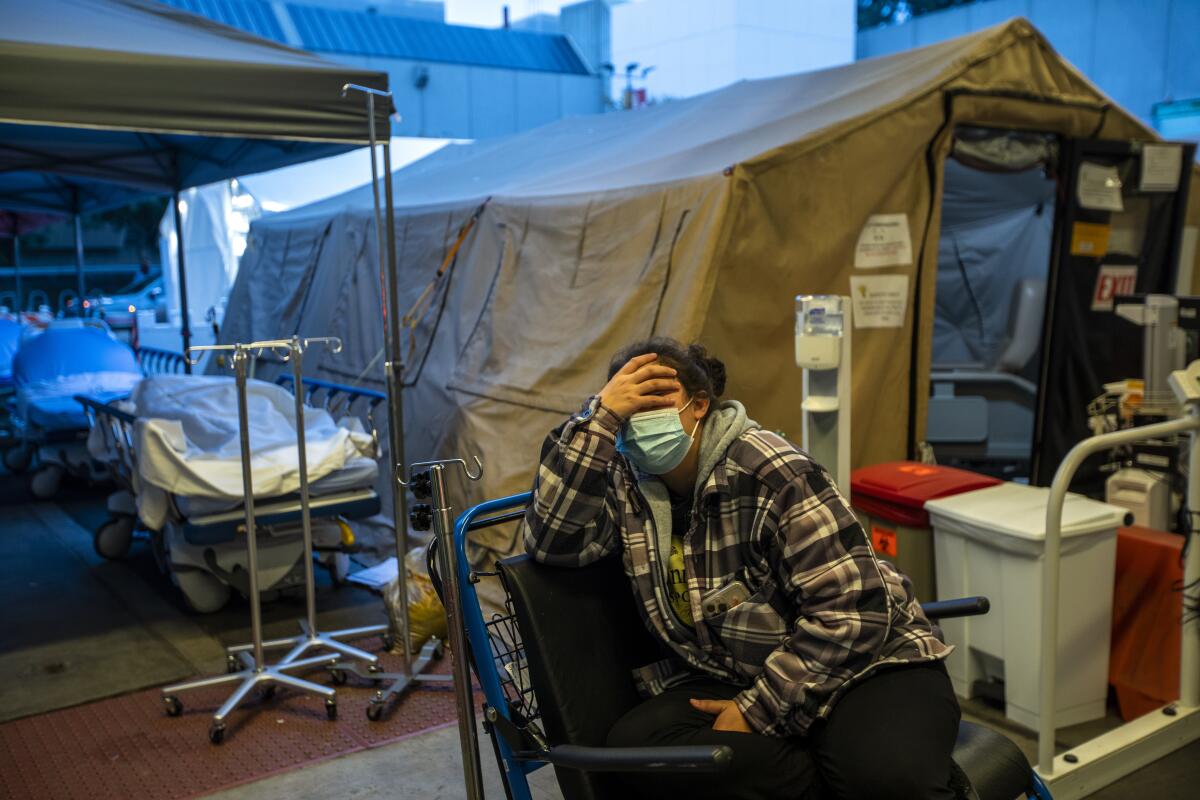
Next, letâs visit Arrowhead Regional Medical Center in Colton, where 44 patients were camped out in the emergency room one day this month. The hospital was already treating more than 100 patients with coronavirus infections, and there was simply no room for more.
Meanwhile, more than two dozen new patients came into the ER. Those who werenât seriously ill were sent home; those with flu-like symptoms were sent to a trailer outside.
Up in the ICU, nurses were tending to three COVID-19 patients apiece, instead of the usual two. Staff shortages were a significant factor, since five nurses were out sick themselves.
Dr. Troy Pennington, an emergency medicine doctor, said this winterâs surge has felt worse than last yearâs. With nearly 45% of San Bernardino County residents not fully vaccinated and a highly contagious variant on the loose, there are more than enough patients to push doctors, nurses and other medical professionals to the brink.
âStaff morale is at one of the lowest Iâve ever seen,â he said.
On to San Diego, where Rady Childrenâs Hospital recently increased the size of its COVID-19 ward by 50% to handle the Omicron surge. Children have had the lowest hospitalization rates throughout the pandemic, but Omicron has pushed them higher than theyâve ever been.
Rady Childrenâs converted an Ebola unit into a COVID-19 unit that now has 45 beds. Most of the hospitalâs COVID-19 patients were admitted for other reasons and discovered their coronavirus infections once they were there. Last week, they included babies with congenital diseases, children with cancer and children awaiting transplants whose procedures were put on hold until the virus was cleared from their bodies.
Roger Ward, whose 6-year-old daughter, Rachel, recently spent time in the hospitalâs COVID-19 unit, was skeptical of the diagnosis. Rachel was brought in for abdominal pain, and no one else in their home had COVID-19 symptoms, he told my colleague Brittny Mejia.
Ward also said he thought the case numbers and seriousness of the disease were exaggerated and that natural immunity is better than the protection offered by vaccines. âI watch Fox News,â he explained.
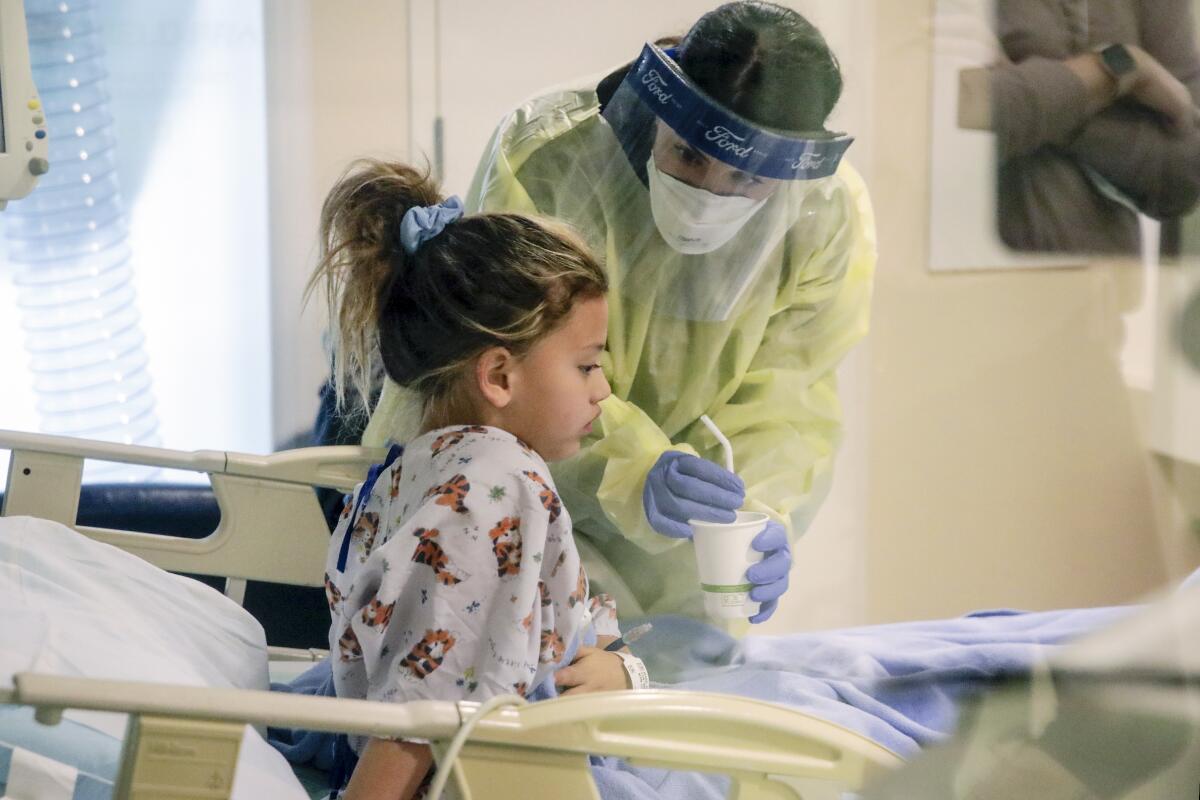
Doctors at Rady Childrenâs have heard similar things from other parents. Dr. John Bradley, the hospitalâs medical director of the division of infectious diseases, said about three-quarters of his patientsâ parents come to regret that they didnât vaccinate their kids, though the remaining 25% doubt it would have made a difference.
If that sounds demoralizing, just listen to whatâs happening a few miles away at UC San Diego Medical Center. Doctors there routinely encounter COVID-19 patients who insist they have the flu and that their unvaccinated status has nothing to do with their illness.
Dr. Venktesh Ramnath, a pulmonologist, described a 40-year-old COVID-19 patient who rejected his treatment advice. Instead, the patient told Ramnath, âI am strong. I am a man. Let me push through this.â He died several weeks later, the doctor recounted in an Op-Ed.
Some family members accuse hospital staff of âpoisoningâ and âpunishingâ their patients. Hereâs Ramnathâs account of a meeting with relatives of a 42-year-old firefighter who denied he had COVID-19 and refused a breathing tube for weeks until he was overcome with excruciating breathlessness:
Because of visitation restrictions to limit contagion, they awaited me in lawn chairs outside the hospital. Through my N95 mask, I tried to explain in simple terms what was happening to their loved one. They hectored with incessant questions about test results, accusations of mistreatment and demands for therapies like vitamins, ivermectin and sedatives.
Warning repeatedly ânot to lie,â they recorded me with their camera phones. I tiptoed through a minefield of distrust. My careful medical explanations and efforts to connect empathically never landed. ... The nurse, an ICU veteran of 20 years, sighed and said: âI canât believe they attacked you like that.â
Californiaâs vaccination progress
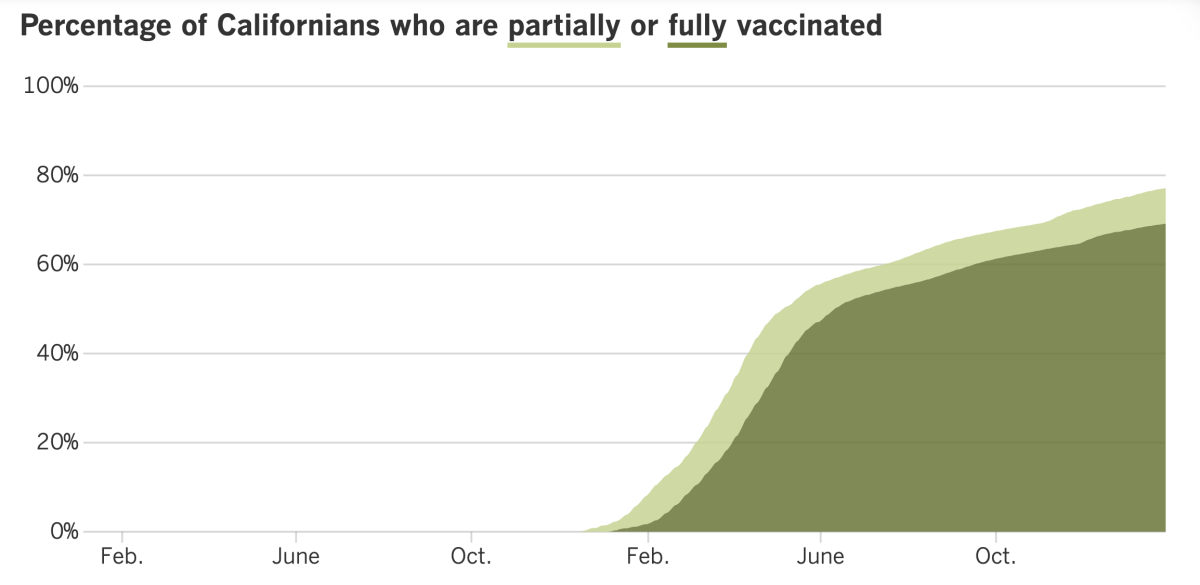
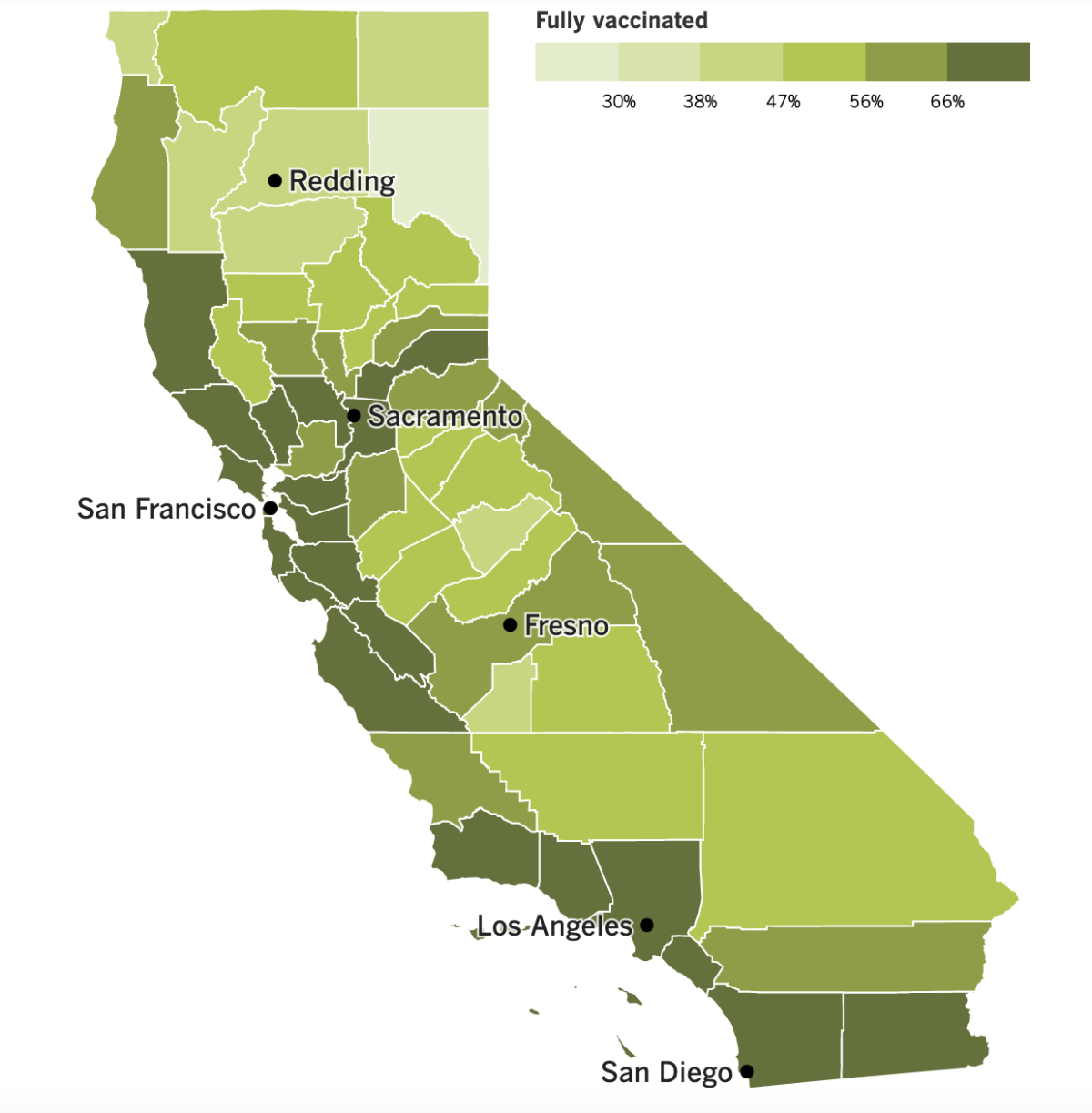
See the latest on Californiaâs vaccination progress with our tracker.
Your support helps us deliver the news that matters most.
In other news ...
Itâs been 10 whole days since weâve marked a coronavirus milestone in this newsletter. Well, you can reset the clock, because as of Wednesday, California has crossed the 8-million mark for coronavirus infections.
In truth, we probably hit that number a while ago, since not everyone who is infected gets tested (and people who test themselves may not have their results included in the official tally). But the official count should give you pause. The state has racked up more than 2.5 million infections since New Yearâs Day. At this rate, it wonât be long until weâve matched 2021âs total of 3.1 million â for the entire year.
Hereâs another startling statistic: Roughly 1 in 5 California residents has caught the coronavirus. (Personally, Iâm more surprised that 4 in 5 have managed to avoid it this long.)
Though it looks like the Omicron wave has peaked here, officials in Los Angeles County are bracing for an onslaught of gatherings that could set us back. What with Sundayâs NFC Championship game between the L.A. Rams and the San Francisco Giants at SoFi Stadium in Inglewood, the Lunar Near Year next week and the Super Bowl at SoFi in mid-February, there will be a lot of opportunities for the coronavirus to spread.
âIf weâre going to be gathering, hosting or attending football-viewing parties, we have to do it sensibly,â said Barbara Ferrer, L.A. Countyâs director of public health. Ferrer & Co. will help with that by making sure high-quality KN95 face masks are handed out to fans attending the Super Bowl.
In San Francisco, the flattening out of the Omicron surge has prompted officials to ease mask rules for vaccinated people spending time in gyms and offices. Rules requiring proof of vaccination to enter restaurants, bars, sports arenas and other venues will also be relaxed, so that those who are unvaccinated may enter if they have proof of a recent negative coronavirus test. The changes take effect Tuesday.
Speaking of rules, the city of Los Angeles has received more than 200 complaints of businesses failing to check that customers are vaccinated before serving them indoors. More than half of the complaints were made against fast food joints, pizzerias and other restaurants, though bars, gyms and beauty salons were called out as well. The complaints triggered official visits to 187 sites as of mid-January.
Despite all those tips and visits, the cityâs Department of Building and Safety has yet to issue a single citation for violating the vaccine verification rules. The ordinance went into effect in early November, with a plan to begin enforcement no sooner than Nov. 29. But the building department opted to extend the âoutreach and educationâ period through January.
Some residents are frustrated by the delay, including Andrew Rudick of Hollywood. He had been looking forward to eating indoors at restaurants again, knowing that the workers and diners around him would be vaccinated. Now he doesnât bother reporting local businesses that arenât following the rules.
âIf thereâs no accountability for public health risks, then whatâs the point of implementing these orders at all?â he said.
In the La Crescenta-Montrose area, some parents are dismayed that the L.A. County Sheriffâs Department hasnât done more to stop a man from harassing middle school children for wearing masks as they walk to and from school. The students are required to wear masks on campus, but the man â whose own children attend the public schools there â has been approaching students since last summer.
Last week, the man was caught on video wearing a T-shirt saying âYour mask makes you look stupidâ and shouting at a group of students huddled near a car. A witness said the man coughed on the students before the video started.
A sheriffâs deputy who was called to the scene wound up lecturing the students about the manâs freedom of speech, according to parent Emily Lanigan.
âWhat the officer did was wrong. I was absolutely shocked,â she said. âIt became clear that the Sheriffâs Department did not take the situation seriously.â
Hereâs something more proactive parents can do to protect their kids: Get vaccinated. A new study from Israel found that unvaccinated children whose mothers and fathers were fully vaccinated were less likely to become infected themselves. That protection was seen against both the Alpha and Delta variants, though in the case of Delta, the protection was strongest when parents had gotten a booster shot.
The findings validate long-held beliefs about the role of vaccines in fostering herd immunity, the studyâs authors said. Dr. Paul Offit, a vaccine specialist at Childrenâs Hospital of Philadelphia who was not involved in the study, agreed.
âHerd immunity also works at the household level,â Offit said. âIf you have a critical number of people in the home who are vaccinated, that works to slow the virusâ transmission.â
In other news, North Korea may be opening up after two years in strict lockdown conditions. Analysts noted that the country recently resumed its freight train traffic into China, a possible sign that the notoriously closed-off country needs outside economic relief. Its COVID-19 immunization campaign was delayed by a year, but if the border reopens, it may resume, analysts said
And finally, after more than two years, the coronavirus has found its way onto the remote Pacific archipelago of Kiribati. The island nation closed its borders at the start of the pandemic and began reopening them this month, allowing the Church of Jesus Christ of Latter-day Saints to charter a plane to fly home 54 citizens who had been out of the country doing missionary work when the closure went into effect.
Kiribati officials went to great lengths in an effort to preserve their coronavirus-free status. The 54 passengers were told to get vaccinated. They were tested three times in nearby Fiji before their plane took off. And when they arrived, they were placed in quarantine and subject to additional testing.
And yet, 36 of the 54 ended up testing positive, and the virus slipped into the community. By Friday, the case count had ballooned to 181, and the government declared a state of disaster.
Your questions answered
Todayâs question comes from readers who want to know: What is BA.2?
This is a new version of the coronavirus that you may know as the âstealthâ Omicron variant. Itâs been found in more than 40 countries, including the United States. (Infections involving BA.2 have been documented in California.) But so far, itâs much more common in Asia and Europe.
BA.2 is a descendent of Omicron, and the two variants share about 20 mutations on the virusâ spike protein. But there are differences. In particular, BA.2 lacks a specific genetic change that makes Omicron easy to differentiate from Delta when using a PCR test. Thatâs where the âstealthâ nickname comes from. Itâs not that BA.2 isnât detectable with a traditional coronavirus test â it is â but the test canât tell that itâs a close relative of Omicron.
BA.2 has other mutations that distinguish it from Omicron, and scientists donât yet understand their significance. Perhaps they make BA.2 even more contagious than Omicron or help it sneak past the immune systemâs defenses or make victims sicker. It will take a few weeks at least to learn more about it.
What is known so far is somewhat encouraging. Scientists in Denmark â where BA.2 accounted for 45% of coronavirus infections in mid-January â compared hospitalization data for Omicron and BA.2 and found no differences.
The World Health Organization is not (yet) concerned enough about BA.2 to give the variant a Greek-letter name. But its quick rise to prominence in some countries means research on it âshould be prioritized,â the agency said.
In the meantime, you can protect yourself against BA.2 the same way you protect yourself against Omicron or any other variant â by getting up to date on your COVID-19 vaccinations, wearing a mask and avoiding crowded spaces.
We want to hear from you. Email us your coronavirus questions, and weâll do our best to answer them. Wondering if your questionâs already been answered? Check out our archive here.
The pandemic in pictures
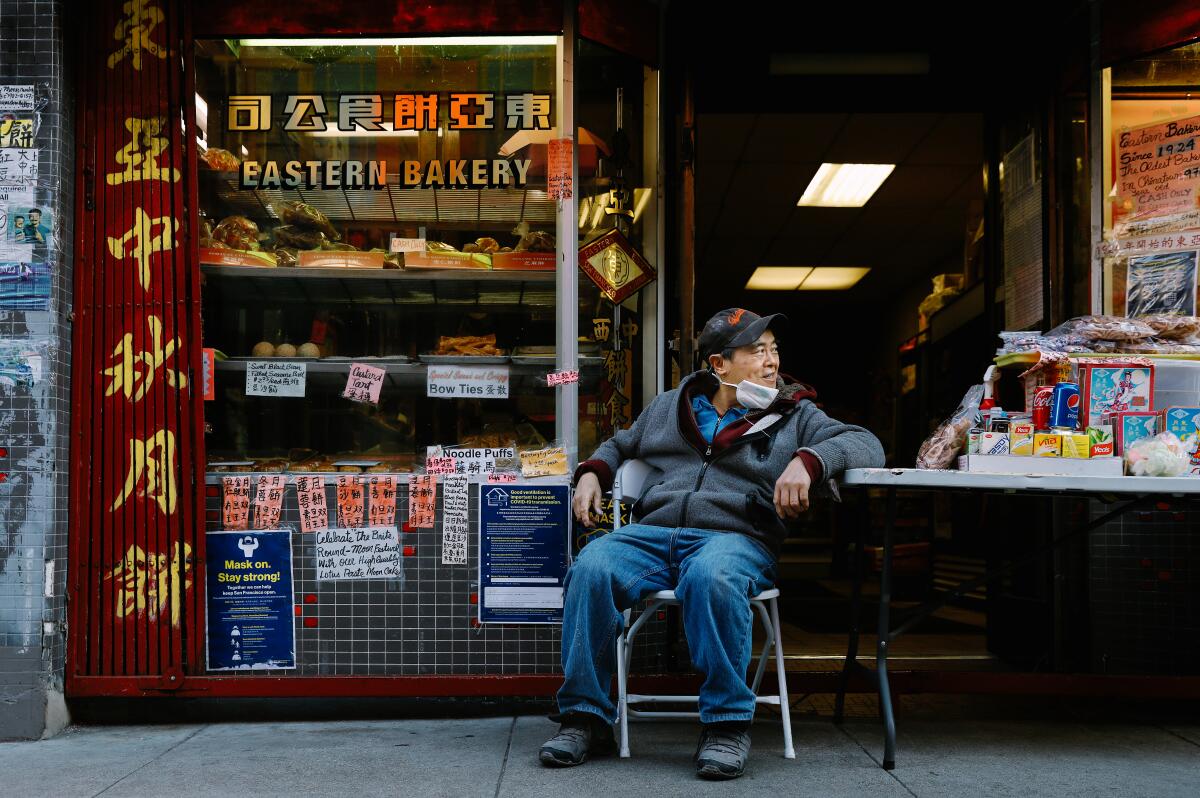
The 70-year-old man in the photo above is Orlando Kuan. Heâs the owner of Eastern Bakery, one of the oldest bakeries in San Franciscoâs Chinatown. The pandemic has forced him onto the sidewalk to drum up sales of his custard tarts, almond cookies and traditional Cantonese snacks.
Foot traffic has been scarce in Chinatown. Tourists are fewer and farther between, and the past two years have trained consumers to shop online as much as possible. The rise of anti-Asian sentiment hasnât helped either.
The 24 blocks that make up this historic neighborhood are littered with casualties in the form of shuttered gift shops and banquet restaurants. Only a fraction have been replaced with hipper, more upscale nightclubs, restaurants and retail.
âThe golden age is gone,â said Stephen Chan, 76, owner of Vyâs Jewelry on Grant. âHalf of the restaurants and half of the retail will not come back.â
Travel writer Christopher Reynolds visited the countryâs oldest Chinatown in advance of the Lunar New Year and found a community caught between its past and its future. When the pandemic is over, it will be different. But will it be less genuine? It depends on how you define âgenuine,â Reynolds writes.
Kevin Chan, owner of the Golden Gate Fortune Cookie Factory, doesnât doubt his neighborhood will be remade by the pandemic. The new generation of patrons âjust want to eat and leave. Theyâre not really into the community,â he said.
âItâs not going to be the old Chinatown.â
Resources
Need a vaccine? Hereâs where to go: City of Los Angeles | Los Angeles County | Kern County | Orange County | Riverside County | San Bernardino County | San Diego County | San Luis Obispo County | Santa Barbara County | Ventura County
Practice social distancing using these tips, and wear a mask or two.
Watch for symptoms such as fever, cough, shortness of breath, chills, shaking with chills, muscle pain, headache, sore throat and loss of taste or smell. Hereâs what to look for and when.
Need to get a test? Testing in California is free, and you can find a site online or call (833) 422-4255.
Americans are hurting in many ways. We have advice for helping kids cope, resources for people experiencing domestic abuse and a newsletter to help you make ends meet.
Weâve answered hundreds of readersâ questions. Explore them in our archive here.
For our most up-to-date coverage, visit our homepage and our Health section, get our breaking news alerts, and follow us on Twitter and Instagram.




